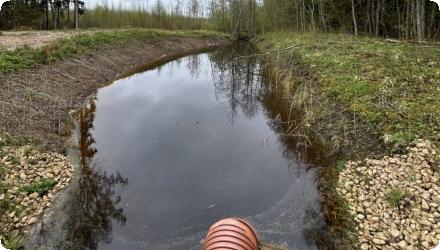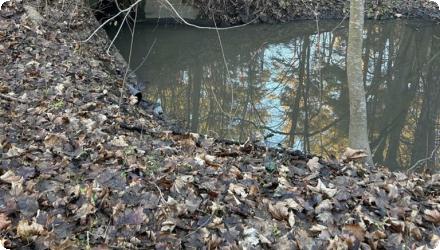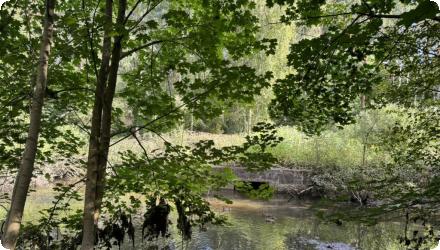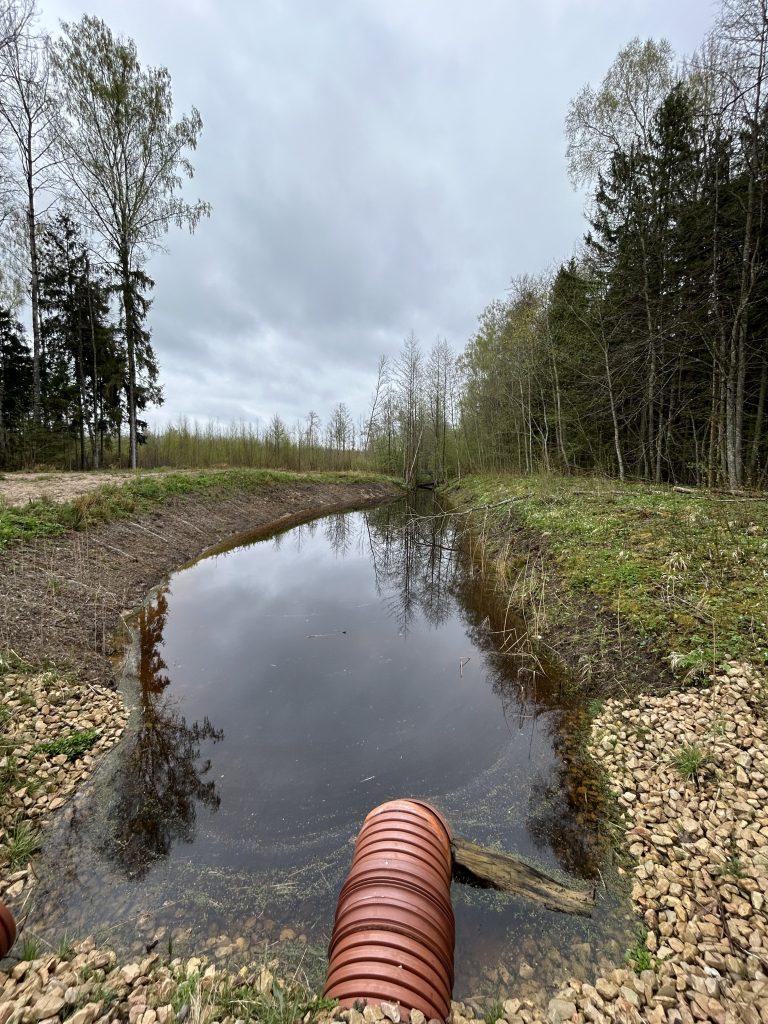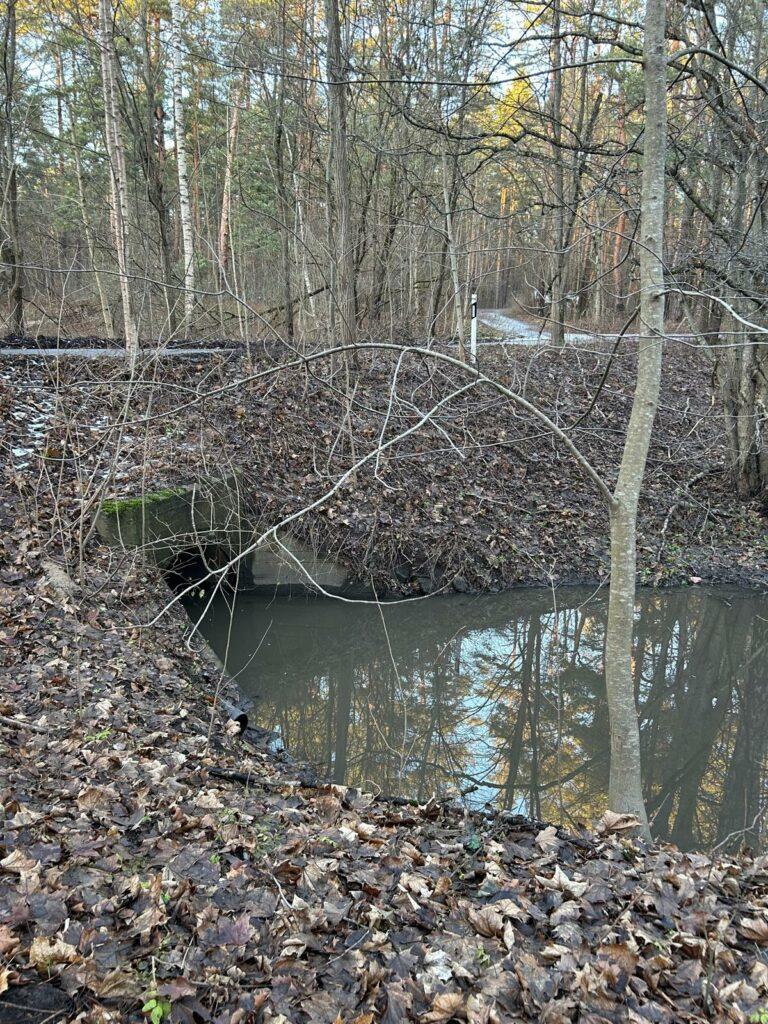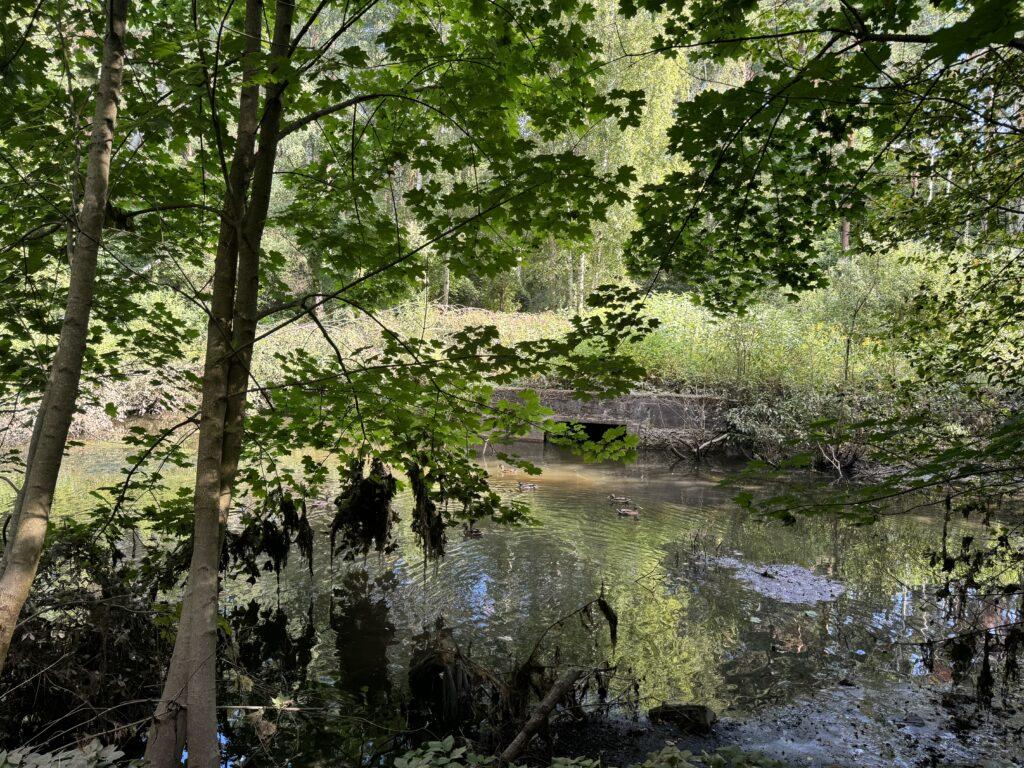Last update
2025
Summary
During recent years the construction of sediment capture ponds as a part of the drainage system has become a good practice measure in the forests managed by Latvian State Forests. Therefore, some of the environmental impacts of this measure have been monitored to justify its costs. The results indicate differences between monitoring sites set up on mineral or peatland soils as well as between different measured parameters. Additionally, it seems that the effectiveness of the measure depends on the skills and quality of the work carried out by professionals constructing the ponds.
Since 2012, several studies led by the Latvian State Forest Research Institute "Silava" have evaluated the water quality outcomes at multiple sites. Results show that sediment capture ponds are generally more effective at reducing total suspended solids (TSS) than at retaining nutrients such as nitrogen or phosphorus. Performance varies between sites and years, but TSS reductions of over 60% have been recorded in some cases. However, nutrient retention has been inconsistent and often negligible.
Recent demonstrations under the LIFE GoodWater IP project have tested alternative designs, including ponds with woodchip filters or peak flow control features. These trials further confirmed that pond shape, design, and local hydrological conditions greatly influence performance. Overall, sediment ponds remain a key component of water protection in Latvian forest drainage systems, but may need to be complemented with additional structures or adapted designs to maximise effectiveness.
Since 2012, several studies led by the Latvian State Forest Research Institute "Silava" have evaluated the water quality outcomes at multiple sites. Results show that sediment capture ponds are generally more effective at reducing total suspended solids (TSS) than at retaining nutrients such as nitrogen or phosphorus. Performance varies between sites and years, but TSS reductions of over 60% have been recorded in some cases. However, nutrient retention has been inconsistent and often negligible.
Recent demonstrations under the LIFE GoodWater IP project have tested alternative designs, including ponds with woodchip filters or peak flow control features. These trials further confirmed that pond shape, design, and local hydrological conditions greatly influence performance. Overall, sediment ponds remain a key component of water protection in Latvian forest drainage systems, but may need to be complemented with additional structures or adapted designs to maximise effectiveness.
Position
Latitude
56.5646
Longitude
24.618
Project
NWRM
National Id
Latvia_02
Implementation Status
Contact
Kristina Veidemane, BEF
Transboundary
0
Photo gallery
Location of the project
Various forest sites accross Latvia.
NUTS Code
LV00 - Latvija
Involved Partners
| Authority type | Authority name | Role | Comments |
|---|---|---|---|
Climate zone
cool temperate moist
Temperature
7
Annual rainfall range
600 - 900 mm
Elevation range
Depends on the site
Water bodies: Ecological Status
Depends on the site
Water bodies: Chemical Status
Failing to achieve good
Project scale
Micro
Project scale specification
The project involves sedimentation ponds installed at specific forest drainage sites managed by Latvia’s State Forests. Each intervention targets a defined catchment or ditch segment (typically <500 ha), with localised monitoring and site-specific construction.
Performance timescale
< 1 year
Project area
272
Lifespan
10
Low-cost integration with existing forest management
50
Functioning of sediment capture ponds depends on the skill of the professionals who construct it.
Costs investment information
The sediment capture ponds are built when the drainage systems are renovated, therefore the direct costs related to sediment ponds are unknown.
Costs operation maintenance information
the ponds shall be cleaned annually
Financing authorities
Type of funding
National funds
Comments
The measure is a part of renovation and maintenance activities of the drainage system.
Type of funding
EU-funds: LIFE+
Compensations
0
Policy context
to prevent erosion and nutrient leackage by reducing stream velocity
Land ownership
State-owned land
Community involvment
No
Design consultation activity
| Activity stage | Name | Key issues | Comments |
|---|
Policy target
| Target purpose |
|---|
|
Pollutants Removal
|
|
Erosion Control
|
Policy pressure
| Pressure directive | Relevant pressure |
|---|
Policy impact
| Impact directive | Relevant impact |
|---|---|
|
WFD identified impact
|
Requirement directive
| Requirement directive | Specification |
|---|
Contractual arrangements
0
| Arrangement type | Responsibility | Role | Name | Comments |
|---|
Part of wider plan
0
Wider plan type
| Wider plan type | Wider plan focus | Name | Comments |
|---|
Since 2020, monitoring has also been integrated into the LIFE GoodWater IP project, coordinated by the Latvian Environment, Geology and Meteorology Centre (LVĢMC).
Total Suspended Solids (TSS)
Dissolved Organic Carbon (DOC)
Total Nitrogen (Ntot), Nitrate (N-NO₃⁻), Ammonium (N-NH₄⁺)
Phosphate (P-PO₄³⁻)
pH, flow velocity, water volume, ditch profiles
In some sites: biogenic element export per hectare
Dissolved Organic Carbon (DOC)
Total Nitrogen (Ntot), Nitrate (N-NO₃⁻), Ammonium (N-NH₄⁺)
Phosphate (P-PO₄³⁻)
pH, flow velocity, water volume, ditch profiles
In some sites: biogenic element export per hectare
samples were take before the sedimentation pond
samples wer taken after the sedimentation pond
Maintenance
Maintenance is carried out by Latvia’s State Forests and includes sediment removal, vegetation control, and structural upkeep. It is done as needed, often following drainage system maintenance.
Catchment outlet
assessment of water quality
By reducing sediment export, ponds help comply with water protection requirements, enabling continued forest operations in sensitive wetland or peatland areas. This supports long-term forest productivity, which is economically important in Latvia (464,000+ ha of drained state forests).
Information on retained water
Water retention: Ponds temporarily retain water from forest drainage ditches, but no quantified data on storage volume or peak flow buffering is provided in current studies.
Information on Peak flow rate reduction
Peak flow control: Some recent designs (e.g. PFC structures) under LIFE GoodWater IP aim to delay outflow during high runoff events, with preliminary success—but no flood control metrics are reported.
Water quality overall improvements
Neutral impact-no change in WQ status
Information on Water quality overall improvements
The monitoring results of 2012/2013 differ among sites, and also among chemical elements. Nutrient concentrations remained generally low but retention was not statistically significant across all sites. No clear retention; in some years, DOC concentrations increased after the pond (e.g., BU1 in 2013: 35.7 mg/L before pond vs. 35.1 mg/L after).
Information on Water quality Improvements (P)
The change in P-PO4 (3+) concentrations is different between the sites - some locations show increase, some decreased and in some no change between inlet and outlet of the sedimentation pond.
Information on Water quality Improvements (N)
The change in total N concentrations is different between the sites - some locations show increase, some decreased when the concentrations between inlet and outlet of the sedimentation pond.
Water quality Improvements (TSS)
The change in TSS is different between the sites - some locations show increase, some decreased when the consentrations between inlet and outlet of the sedimentation pond. E.g., up to 62–70% reduction in TSS in standard ponds and PFC structures. TSS levels in sites like ST2 dropped from 43 mg/L to <5 mg/L over time.
Soil quality overall soil improvements
Neutral impact-no change in SQ status
0
Ponds likely create small aquatic habitats in drained forest landscapes, which may support macroinvertebrates or amphibians, though this remains unverified.
Ecosystem impact climate regulation
No specific impact
Key lessons
The measures to build sedimentation ponds in forest drainage systems have been implemented in Latvia; however their impact on the water quality has not been evaluated. The case study presents the research results of monitoring of impact on water quality due to installation of the sedimentation pond. The results indicate that the values differ between the years of installement. It is importan that the ponds are installed that the river water can not be flow into the draianage system as well the ponds should be cleaned annually.
Design matters for effectiveness : Pond shape, size, and construction quality strongly influence sediment retention. Poorly designed or undersized ponds show limited impact. Ponds built to a standard size (~3 m²/ha or more) tend to perform better.
Good for sediments, weak for nutrients : Ponds are effective at reducing total suspended solids (TSS), with reductions up to 70% in some sites. However, they are not reliably effective for retaining nitrogen, phosphorus, or DOC.
Site conditions drive performance : Results vary significantly by soil type (mineral vs peat), hydrology, and sediment load. Maintenance activities (e.g. prolonged ditch works) can temporarily reduce pond effectiveness.
Integration into routine forest management is key : Incorporating ponds into regular drainage maintenance makes implementation cost-effective and logistically feasible.
Complementary measures may be needed : For improved nutrient retention or hydrologic regulation, additional structures (e.g. Peak Flow Control, woodchip filters) may be necessary.
Monitoring is essential : Regular sampling before/after ponds provides insight into their actual function and guides design improvements. Long-term monitoring helps account for seasonal and annual variability.
Design matters for effectiveness : Pond shape, size, and construction quality strongly influence sediment retention. Poorly designed or undersized ponds show limited impact. Ponds built to a standard size (~3 m²/ha or more) tend to perform better.
Good for sediments, weak for nutrients : Ponds are effective at reducing total suspended solids (TSS), with reductions up to 70% in some sites. However, they are not reliably effective for retaining nitrogen, phosphorus, or DOC.
Site conditions drive performance : Results vary significantly by soil type (mineral vs peat), hydrology, and sediment load. Maintenance activities (e.g. prolonged ditch works) can temporarily reduce pond effectiveness.
Integration into routine forest management is key : Incorporating ponds into regular drainage maintenance makes implementation cost-effective and logistically feasible.
Complementary measures may be needed : For improved nutrient retention or hydrologic regulation, additional structures (e.g. Peak Flow Control, woodchip filters) may be necessary.
Monitoring is essential : Regular sampling before/after ponds provides insight into their actual function and guides design improvements. Long-term monitoring helps account for seasonal and annual variability.
Success factor(s)
| Success factor type | Success factor role | Comments | Order |
|---|---|---|---|
|
Attitude of relevant stakeholders
|
The sediment capture ponds are promoted by NGOs and some scientific literature, therefore if the monitoring results in upcomong years will be convincing then the measure could be continued. |
1
|
Driver
| Driver type | Driver role | Comments | Order |
|---|---|---|---|
|
Organisation committed to it
|
main driver
|
"Latvian State Forests" has introduced this measure as good management practice
|
1
|
|
Public pressure
|
secondary driver
|
NGOs are concerned about the impact of drainage systems on water and fish resources
|
2
|
Transferability
This low-cost, simple measure is highly transferable to other managed forest areas with artificial drainage, especially in boreal and temperate zones. However, its effectiveness depends on site conditions, pond sizing, and construction quality. It works well for sediment retention but is less effective for nutrients. Careful design, professional implementation, and basic monitoring are essential. Combining it with other measures may be needed to meet broader water quality goals.
English
